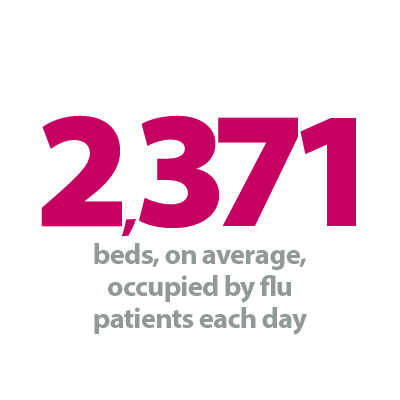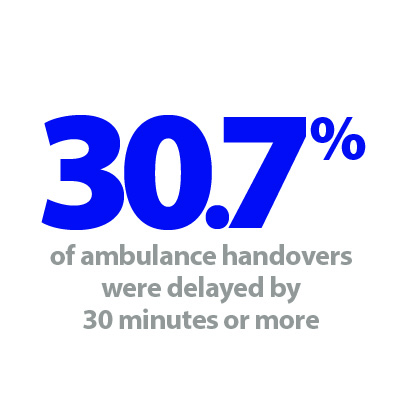


Introduction
Today the weekly winter situation reports were published by NHS England, alongside the monthly performance and activity statistics. As always, these offer a valuable insight into the performance and activity of trusts on the ground.
This week's winter data (29 January – 4 February) once again demonstrate the pressures of seasonal illnesses as we see the highest number of hospital beds taken up by flu patients so far this winter. Demand continues to be felt across urgent and emergency care, as this week saw more patients arriving by ambulance than the same point last year, alongside an increase in hours lost due to ambulance handover delays.
The latest performance and activity data also highlight the challenges in mental health and community settings. These data reveal concerningly high levels of referrals in these sectors, which are significantly higher than pre-pandemic levels. The performance and activity statistics provide useful context to the state of the sector. Key points to highlight include:
Ambulance activity: Although the number of category 1 and category 2 incidents slightly decreased this month, it was one of the busiest Januarys on record. Average response times for category 1 and category 2 incidents improved in the latest month but both are missing the NHS national targets.
Emergency care activity: This was the busiest January on record for A&E. There was a slight improvement in the four-hour waiting time target although this is still falling short of the 76% recovery target. The number of patients waiting longer than 12 hours from decision to admit to admission reached 54,000.
Elective care: Elective care activity decreased across the board in December, but the waiting list fell slightly, although this remains high at 7.6m. The number of those waiting more than 18 and 78 weeks increased this month but those waiting longer than 52 weeks has fallen.
Diagnostics: Diagnostic activity reduced in December with over 2m diagnostic tests carried out. Despite this, the waiting list has decreased in the latest month.
Cancer: December saw a decrease in activity for the three cancer standards, but more people received a confirmation or ruling out of cancer within 28 days, with 74.2% of patients told an outcome of their cancer diagnosis within four weeks of an urgent GP referral for suspected cancer.
Urgent community response: As of November 2023, 84.2% of urgent community response referrals met the two-hour standard for delivery.
Mental health: December 2023 saw a rise in the number of people in contact with and referrals to mental health services. Referrals for children and young people are considerably greater than before the pandemic.
Winter situation report (29 January – 4 February)
A&E closures & diverts: There were no A&E closures this week. There were a total of 31 A&E diverts this week, three more than the week prior and 14 more than the same week last year.
Ambulance arrivals: A total of 90,861 patients arrived by ambulance, an increase of 0.9% since last week and up 12.9% from last year.
Ambulance handovers: 30.7% of ambulance handovers were delayed by 30 minutes or more, down from 33.9% last week. 12.1% were delayed by 60 minutes or more, down from 15.4% last week. The total hours lost to ambulance handover delays has fallen to 24,372 hours but is greater than the same week last year (+51%).
Critical care: Adult critical care bed occupancy is at 82.2% this week, a slight decrease from 82.6% last week but remains higher than this time last year (79.4%).
Diarrhoea and vomiting (D&V): The number of beds closed due to D&V and norovirus decreased this week with an average of 687 beds closed per day. This is down from 798 last week.
Discharges: There were an average of 24,531 patients each day who no longer met the criteria to reside. This is slightly greater than last week; however, a smaller proportion of patients remained in hospital this week (55.7%).
Flu: This week the average number of general and acute beds occupied by flu patients each day was at 2,371, an increase of 10.7%. An average of 106 critical care beds were occupied by flu patients each day this week (26.5% more than the week before).
General and acute (G&A) beds: There were an average of 103,584 G&A beds open each day across all acute trusts. On average each day, 103 G&A beds were unavailable and void to non-Covid infections. Bed occupancy remained at a similar level to last week at 94.7%.
Long stay: The number of patients staying in hospital longer than seven, 14, and 21 days all slightly increased this week (up by 0.6%, 1%, and 0.1% respectively).
Neonatal intensive care beds: Bed occupancy has decreased slightly from last week to 66.5%; down from 66.8% last week. The average number of care beds open is at 1,709, a decrease of two beds in the last week.
Paediatric intensive care beds: Bed occupancy has decreased this week to 78.7%, down from 80.8% last week. The average number of care beds open this week has remained at the same level as last week at 365.
Respiratory syncytial virus (RSV): An average of 22 beds were closed this week due to RSV symptoms; one less bed compared to the previous week.
Staff absences: There were an average of 49,620 total absences each day this week, of which 4% were Covid-19 related (1,775). The total number of staff absences increased slightly from the week before (49,212) but the proportion of Covid-19 related absences was the same.
Our view
The monthly performance data and winter sitrep data show a health and care system that is responding to huge seasonal pressures.
The latest statistics for the mental health sector show that demand has surged and is at higher levels now compared to before the pandemic. In December there were 1.87 million people in contact with mental health services. Trust leaders are particularly worried about children and young people's mental health services, with the number of open referrals being 90% higher than four years ago.
Waiting lists also continue to grow for community trusts, with 965,715 on a community waiting list in December 2023. Patient flow across health and care continues to be protracted, with high numbers of people residing in hospital, despite being fit for discharge. Limited home care packages and social care provision remains a significant challenge.
In December, marginal gains were made to the elective care waiting list which fell slightly to 7.6m. However, this was largely attributable to fewer numbers of people joining the waiting list. Overall, activity across diagnostics, surgery and cancer care slipped compared to a busy and successful November. However, industrial action throughout the winter has led to thousands of cancelled operations and trusts are continually playing catch up.
Seasonal illnesses continue to add significant strain. With nearly 2,400 beds being occupied by patients with flu. Average bed occupancy across hospitals remains high and staffing absences add further daily tests to operational managers.
January's data and the latest winter situation reports data show an urgent and care system under immense pressure. It was the busiest January on record in terms of A&E attendances and ambulance call outs. Some small improvements were made in ambulance response times, and this winter the work to reduce handover delays has seen some returns in certain parts of the country. There were also high numbers of emergency admissions and the number of people waiting more than 12 hours from the decision to admit reached 54,000. These delays before admission, alongside handover delays and delayed discharges are the signs of a system under immense pressure.
King George Hospital introducing initiatives to reduce patient handover delays
For this week's NHS Winter Watch campaign, we take a look at the initiatives King George Hospital are undertaking to reduce patient handover delays.
King George Hospital, located in Ilford, London, is part of Barking, Havering and Redbridge University Hospitals NHS Trust. The volume of patient handovers at the hospital has grown steadily across the year, increasing from an average of 35 a day in early April 2023 to 43 a day in late November 2023, excluding priority calls. This compares with an average of 50 patient handovers each day across trusts in England.
The proportion of King George Hospital's handovers taking an hour or longer tracked the average for England until the second half of 2022. Between August and December 2022, the hospital's hour-plus handovers increased sharply. They peaked at 38% in December 2022, while the national average was 23%. Since July, the hospital's hour-plus delays have dropped sharply, most recently accounting for 1% of all the hospital's handovers: over the same time the national figure has increased, doubling from 6% in July to 13% in October 2023.
For the first three months of 2023, the hospital's average handover time was around 50-minutes, 18-minutes slower than the national figure. Over the last three months of 2023, the hospital's average handover time had decreased to 23-minutes, 10 minutes faster than the national figure for that period.
A number of initiatives at King George Hospital have contributed to the reduction of handover delays. These include close collaboration with the ambulance trust, pre-emptive information sharing, roles dedicated to improving patients' handover experience and integration of W45 (hospital withdrawal procedure) into standard practice.
Culture and leadership
The hospital has recently appointed a new managing director who has embraced close working with the ambulance trust as well as taking a whole hospital approach – from admission to discharge – in reducing the risks held in the community, with London Ambulance Service (LAS) and within their emergency department. This has helped infuse a culture of collaboration and proactive intervention, designed to reduce patient handover delays while also focusing on the broader patient journey.
Dedication role-allocation
There are four (integrated care board funded) improvement managers now in place, dedicated to focus on improving patient handover experience.
Communication
Regular meetings between the hospital's managing director and LAS' associate director of ambulance operations have fostered a collaborative approach to reducing delays, ensuring resources from both sources are deployed efficiently and directly related to demand. Early-alerts are also communicated via a specifically created WhatsApp group, in addition the management teams from the emergency department and local ambulance station also meet on a regular basis to talk through issues and solutions.
Integration of W45 into standard practice
The hospital has embraced the practice, launched nationally in January 2023, which sees complete and safe patient handover within 45-minutes of the ambulance's arrival at the emergency department. King George Hospital has also considered moving to a 30-minute target.
Pre-emptive information sharing
The hospital has adopted the Cambridge Model for rapid handover, combined with the approach used by Homerton Hospital (also featured in Association of Ambulance Chief Executives case studies). This helps ensure the hospital has a clear understanding of the patient's medical needs pre-arrival, resulting in a more effective handover once the ambulance arrives.
Focus on patient wellbeing
The demographic profile of the population served by King George Hospital means that they are – by necessity – reliant on a high degree of social care.
Diverting local patients to hospitals other than King George will delay patient discharge, and reducing handover delays at the hospital ensures patients are treated in their local emergency departments, that patient flow is improved and that individuals are discharged appropriately.
This case study was provided by Association of Ambulance Chief Executives as part of their ongoing hospital handover case study series. You can access other hospital case studies.